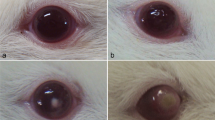Abstract
In this article, the results of investigations concerning a parasitic endocytobiont within the host amoebae (Acanthamoeba sp.) are presented. The endocytobiont was recently isolated from the contact lens and the inflamed eye of a patient with keratitis. Light microscopy and electron microscopy were performed to provide morphological details: Light microscopy revealed the presence of ovoid microorganisms developing and proliferating within the cytoplasm of the amoebic trophozoites. Details of the unusual development of these endocytobionts within the amoebae could be studied and demonstrated by means of electron microscopy. Foldings and morphological reorganization of the microorganisms took place exclusively within the host cytoplasm. The intracellularly aggregating organisms led to the rupture of the Acanthamoeba trophozoites after proliferation. Numerous microorganisms were released, which were infectious and were subsequently ingested by hitherto uninfected acanthamoebic trophozoites. To evaluate the in vitro growth of the isolated endocytobionts (without their hosts), they were transferred to several different culture plates. There was no growth of these unique organisms on five different common cultural plates suitable for the growth of bacteria and fungi.










Similar content being viewed by others
References
Barker J, Lambert PA, Brown MRW (1992) Influence of intra-amoebic and other growth conditions on the surface properties of Legionella pneumophila. Infect Immun 61:3503–3510
De Jonckheere JF (1977) Use of an axenic medium for differentiation between pathogenic an non-pathogenic Naegleria fowleri isolates. Appl Environ Microbiol 33:751–757
De Jonckheere JF (1980) Growth characteristics, cytopathic effect in cell culture, and virulence in mice of 36 type strains belonging to 19 different Acanthamoeba spp. Appl Environ Microbiol 39:681–685
Hoffmann R, Michel R, Müller K-D, Schmid EN (1998) Archaea-like endocytobiotic organisms isolated from Acanthamoeba sp. (Gr II). Endocytobiosis Cell Res 12:185–188
Kennedy SM, Devine P et al (1995) Corneal infection associated with Hartmannella vermiformis in contact-lens wearer. Lancet 346:637–638
Kirkness CM, Aiken D et al (1993) Vahlkampfiids keratitis simulating Acanthamoeba infection associated with disposable contact lens wear (an overlooked diagnosis). Invest Ophthalmol Vis Sci 334:853
Michel R (1997) Freilebende Amöben als Wirte und Vehikel vonMikroorganismen. Mitt Österr Ges Tropenmed Parasitol 19:11–20
Michel R (2006) Isolation of free-living amoebae from various sources harbouring pro- and eukaryotic endocytobionts. Endocytobiosis Cell Res 17:127–136
Michel R, Schmid EN, Böker T, Hager DG, Müller K-D, Hoffmann R, Seitz HM (2000) Vannella sp. harboring Microsporidia-like organisms isolated from the contact lens and inflamed eye of a female keratitis patient. Parasitol Res 86:514–520
Michel R, Muller KD, Schmid EN, Zöller L, Hoffmann R (2003) Endocytobiont KC5/2 induces transformation into sol-like cytoplasm of its host Acanthamoeba sp. as substrate for its own development. Parasitol Res 90:52–56
Page FC (1988) A new key to freshwater and soil Gymnamoebae with instructions for culture. Culture collection of algae and protozoa
Rowbotham TJ (1980) Preliminary report on the pathogenicity of Legionella pneumophila for freshwater and soil amoebae. J Clin Pathol 33:1179–1183
Scheid P (2007) Mechanism of intrusion of a microsporidian-like organism into the nucleus of host amoebae (Vannella sp.) isolated from a keratitis patient. Parasitol Res 101:1097–1102
Scheid P (2008) Freilebende Amöben als Krankheitserreger und Vektoren. Wehrmedizinische Monatsschrift 52(Heft 5–6):171–175
Scheid P, Pressmar S, Richard G, Zöller R, Michel R (2008) An extraordinary endocytobiont in Acanthamoeba sp. isolated from a patient with keratitis. Parasitol Res 102(5):945–950
Acknowledgements
We like to thank Dr. Dave Lam for his support and Elke Schneider for her help and assistance in obtaining these impressive electron micrographs.
Author information
Authors and Affiliations
Corresponding author
Rights and permissions
About this article
Cite this article
Scheid, P., Hauröder, B. & Michel, R. Investigations of an extraordinary endocytobiont in Acanthamoeba sp.: development and replication. Parasitol Res 106, 1371–1377 (2010). https://doi.org/10.1007/s00436-010-1811-4
Received:
Accepted:
Published:
Issue Date:
DOI: https://doi.org/10.1007/s00436-010-1811-4




